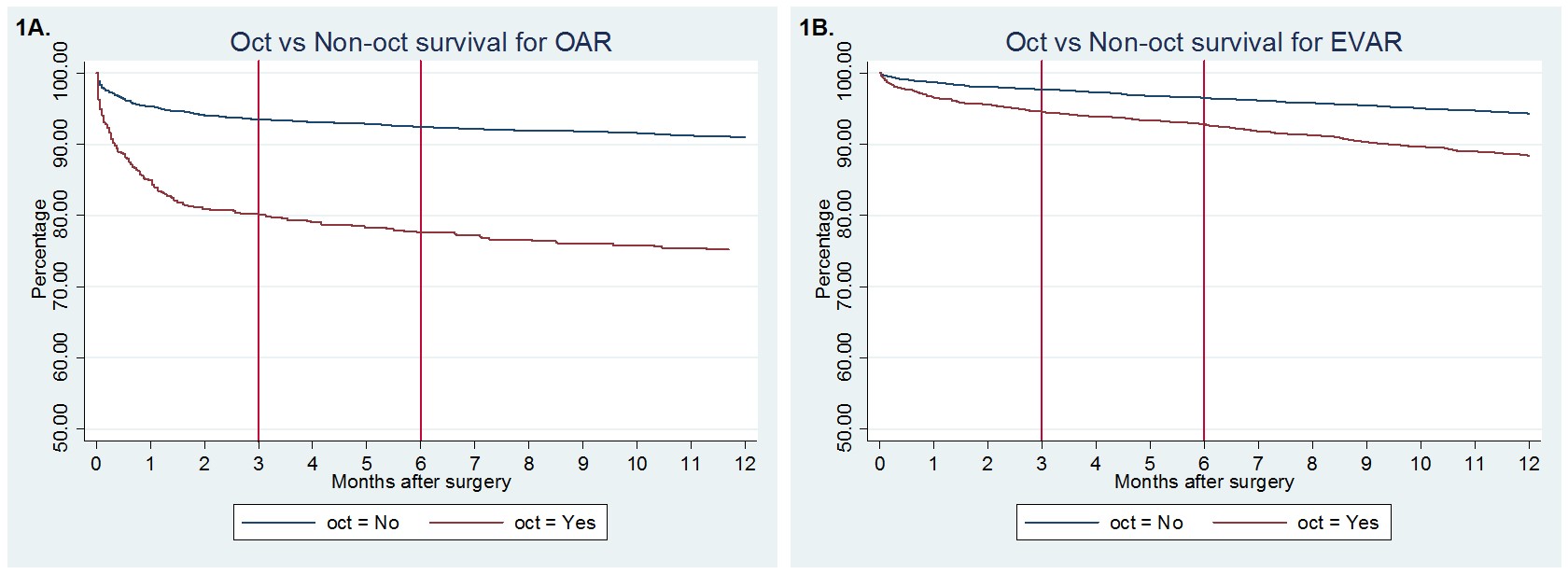|
Back to 2016 Annual Symposium ePosters
AAA Repair in Octogenarians: Is it Worth the Risk?
Caitlin W. Hicks, MD, MS1, Tammam Obeid, MD1, Isibor Arhuidese, MD, MPH2, Umair Qazi, MD, MPH1, Mahmoud B. Malas, MD, MHS1.
1Johns Hopkins Medical Institutions, Baltimore, MD, USA, 2The Johns Hopkins Hospital, Baltimore, MD, USA.
OBJECTIVES:
Age is a well-known independent risk factor for mortality after AAA repair. However, there is significant debate about the utility of AAA repair in older patients. We aimed to compare mortality outcomes following endovascular AAA repair (EVAR) and open AAA repair (OAR) in octogenarians (age≥ 80 years) compared to younger patients (age <80 years).
METHODS:
All patients recorded in the Vascular Quality Initiative database (2002-2012) who underwent infrarenal AAA repair were included. Univariable and multivariable statistics were used to compare perioperative (30-day) and one-year mortality outcomes between octogenarians vs. non-octogenarians for both OAR and EVAR procedures.
RESULTS:
Overall, 21,874 patients underwent AAA repair during the study period (OAR=5,765; EVAR=16,109), including 4,839 octogenarians (OAR=765; EVAR=4,074) and 17,035 non-octogenarians (OAR=5,000; EVAR=12,035). Octogenarians (mean age 83.01±0.09 years) were less frequently male (66% vs. 75%) and had a higher prevalence of congestive heart disease (9.9% vs 7.1%), chronic renal insufficiency (12.2% vs. 7.5%), and a history of prior aortic surgery (14.3% vs. 7.7%) compared to non-octogenarians (all, p<0.001). Intraoperative use of blood transfusions and vasopressors were more common in octogenarians for both OAR (blood: 3.3±4.4 1.8±3.7 units; vasopressors: 45.2 vs. 32.8%) and EVAR (blood: 0.43±1.7 vs. 0.31±1.6; vasopressors: 7.6% vs. 5.7%) (all, p<0.001). Contrast dye volumes used during EVAR were similar between groups (108±71 vs. 107±68 cc; p=0.18). Perioperative mortality following OAR was 20.1% in the octogenarian group, compared to 7.1% in non-octogenarians (p<0.001). Perioperative mortality following EVAR was 3.8% in the octogenarian group, compared to 1.6% in non-octogenarians (p<0.001). One-year mortality among octogenarians vs. non-octogenarians was 24.8% vs. 9.0% and 11.6% vs. 5.7% for OAR (Figure 1A) and EVAR (Figure 1B), respectively (both, log-rank test p<0.001). Multivariable analysis controlling for baseline and intraoperative differences between groups demonstrated that age≥ 80 years increased risk of 30-day and 1-year mortality following AAA repair by 236% and 194%, respectively (both, p<0.001).
CONCLUSIONS:
AAA repair should be approached with extreme caution in the octogenarian population. Perioperative and 1-year mortality rates following OAR are particularly high in this age group, suggesting that the risk associated with open surgery may outweigh the benefits in older patients. 
Back to 2016 Annual Symposium ePosters
|







